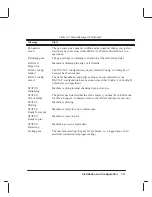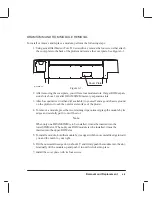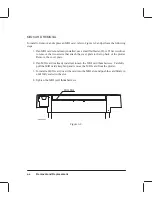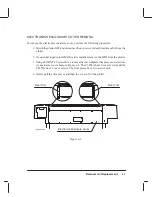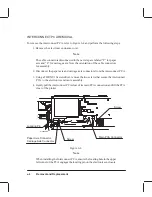
5-4
Functional Overview
An internal cooling fan is supplied with +12 V. It is switched ON and OFF by the servo pro-
cessor and is mounted in the electronics enclosure at the rear of the plotter. The fan is primari-
ly used to cool the power supply PCA when plotting. When the plotter is not plotting, the fan
is switched OFF. At high temperatures, the fan is switched ON.
The window sensor is a switch mounted on the right sideplate at its top front edge. Feedback
about the window’s position (up or down) is sent to the main PCA through the front panel.
An optical pinch wheel sensor is mounted on the lower rear portion of the plotter’s right side-
plate and is electrically connected to the main PCA. When the pinch arms are raised, a cam in
the pincharm lift mechanism interrupts the beam of the optical sensor, and, when the pin-
charms are lowered, the beam is not interrupted. Thus, the position of the pincharms can be
determined from the electrical state of the sensor.
The media sensor is also an optical sensor and is mounted toward the right end of the entry
platen. A reflective label, located under the cutter enclosure, provides a reflective surface for
the sensor. A base intensity level for reflected light is determined for the sensor in the absence
of media. This intensity level is stored in the EEROM. It is calculated when a new main PCA
with a blank EEROM is first powered-up, or after the EEROM has been cleared. When media
is loaded, a difference between the new intensity level and the base intensity level indicates
that media is present. This sensor provides a leading and trailing edge-sensing capability (for
media length measurement) to the plotter. The media sensor is electrically connected to the
main PCA.
The drop sensor is an infrared detector mounted in the service station. It is used to test that the
nozzles in the pen cartridge are operating properly. It is part of a drop-detection system that
measures the time from the firing of a nozzle to the sensing of a drop (typically < 900
sec).
The operation of the sensor system depends upon an illuminated infrared optical path, in
which the received power is modulated a small amount by a drop passing through an aperture
on the way to the waste containment system. The illumination is provided by an infrared LED
which is regulated by an automatic power control to provide a fixed operating point in the
optical receiver photo-diode. The automatic power control compensates for contamination,
device aging, and environmental effects.
An optical sensor mounted on the primer assembly is used to determine the initial position of
the primer assembly cam. When the stepper motor that drives the primer assembly rotates in
one direction, it obtains the values for selecting each pen for priming. When rotated in the
opposite direction, a clutch engages a diaphragm to provide the vacuum for priming.
An optical sensor on the service station housing is used to determine the position of the bail.
When the bail is in the “down” position, the photo beam is interrupted by a small plastic flag
actuated by the bail. When it is up, the photo beam path is clear. The resulting BAIL logic
level is sent to the main PCA by way of the service station cable. The service station cable
assembly consists of the drop detect and bail sensors, the stepper motor and the primer sensor.
Summary of Contents for C2858A
Page 125: ...7 10 Adjustments Calibrations Notes ...
Page 155: ...9 4 Product History Notes ...
Page 164: ...10 9 Parts and Diagrams Illustrated Parts Breakdown C2859A Electronics Enclosure C C2858 3 1 ...
Page 166: ...10 11 Parts and Diagrams Illustrated Parts Breakdown C2858A Electronics Enclosure C C2858 4 1 ...
Page 182: ...10 27 Parts and Diagrams Illustrated Parts Breakdown Paper Drive Assemblies C C2858 12 1 ...
Page 198: ... ...




